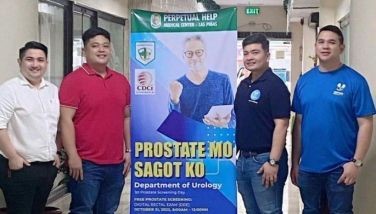UPLB units work to enhance control of animal diseases
December 30, 2001 | 12:00am
Assisting the local livestock and poultry industries in improving their productivity are three units at the University of the Philippines, Los Baños. Using molecular technologies in research and development, the College of Veterinary Medicine (CVM), the Dairy Training and Research Institute (DTRI) and the Institute of Animal Science (IAS) are working to enhance the diagnosis and control of diseases and improve the breeding stocks of animals of economic importance.
Animal diseases, considered a major constraint to animal production in the country, can be controlled through vaccines and proper diagnoses, says CVM dean Dr. Eduardo L. Salcedo. It is in the area of vaccine production and disease diagnostics that CVM is hoping to carve a niche, starting with the most common animal diseases.
Under the leadership of CVM’s Dr. Helen Molina, a team of scientists has developed an oil adjuvenated vaccine for pasteurellosis in cattle. The vaccine is currently being patented.
Pasteurellosis is the number one killer disease of local food animals. It is a blood infection caused by a bacterial organism. Hemorrhagic septicemia (HS) strain pasteurella multocida affects cattle and carabao, the fowl cholera strain affects chickens and ducks and swine plague strain affects pigs.
"All cattle are prone to this disease which causes sudden death. It has a short incubation period, and sometimes without clinical signs, the cow just dies. If there are clinical signs, these are not detected because of the speed of the disease process," Molina explained.
Vaccination is the most practical method of controlling it. However, she pointed out that vaccines available for said disease are not effective for the local animals because they are imported and produced from foreign and non-specific bacterial strains.
Molina and her team developed the vaccine using locally isolated strains of the bacterial organism. It has been proven to be stable for more than two years when refrigerated, it used no adverse side effects, and offered protection to the animals for more than a year. It has passed the quality control requirements of the Bureau of Animal Industry for various tests and is presently undergoing tests for field trials.
A vaccine against infectious corayza in chicken has likewise been developed and is also being tested. The disease, which rapidly spreads to other hens, causes the fowl’s eyes and face to swell, making it unable to feed, which eventually results in death.
According to Molina, it takes about five years to develop a vaccine until it can be commercially available. "At present, 20 to 30 percent of vaccines for HS is cattle and buffaloes today are imported, while for chicken, 100 percent of vaccines are imported," she said.
Meanwhile, the IAS is primarily concerned with the genetic improvement and production of cattle breed stocks using animal reproductive biotechnologies as multiple ovulation and embryo transfer (MOET). In embryo transfer, fertilized eggs and embryos collected from donors are transferred into the uterus of recipients.
A current project headed by IAS’ Dr. Orville Bondoc provides key data on the comparative success rates and costs of producing fresh embryos on five breeds of donor cows cattle using two kinds of multiple ovulation or superovulation drugs.
Twenty-one cows consisting of the beef type Native and Brahma, and dairy types Australian Friesian Sahiwal, F1 Holstein xJersey cross, and F1 Hoslstein x Sahiwal cross were superovulated with either the follicle stimulating hormones o-FSH (Embryo-S®) and p-FSH (Folltropin-V®).
After estrus was detected in the cows, these were inseminated with frozen-thawed bull semen, and 75 embryos were recovered non-surgically on day seven after the onset of estrus. The study found that on the average, 70 percent of the embryos collected were transferable or with good or excellent classification. The Department of Agriculture through the Bureau of Agricultural Research provided funds for the project.
Freezing or cryopreservation of sperms and embryos as an integral part of the methods to control animal reproduction has been successfully demonstrated at DTRI. A team of researchers is using the technology to establish a nucleus herd of superior dairy animals for future milk production and to establish a gene bank of vitrified embryos that will hold the presentative lines of crossbred daily animals for future breeding and testing programs. The project is under the leadership of Dr. Jose Arceo N. Bautista, with funds provided by the Philippine Council for Agriculture, Forestry and Natural Research and Development.
Already, three calves have been born from the transfer of fresh and vitrified embryos, and more calves are expected from the pregnant cows and heifers that were transplanted with embryos collected at DTRI. Sharing the technology for the benefit of its ultimate stakeholders in the industry, the Institute will soon be conducting training packages on bovine embryo transfer for the Department of Agriculture specialists and members of the Cattle Raisers Association of the Philippines.
Animal diseases, considered a major constraint to animal production in the country, can be controlled through vaccines and proper diagnoses, says CVM dean Dr. Eduardo L. Salcedo. It is in the area of vaccine production and disease diagnostics that CVM is hoping to carve a niche, starting with the most common animal diseases.
Under the leadership of CVM’s Dr. Helen Molina, a team of scientists has developed an oil adjuvenated vaccine for pasteurellosis in cattle. The vaccine is currently being patented.
Pasteurellosis is the number one killer disease of local food animals. It is a blood infection caused by a bacterial organism. Hemorrhagic septicemia (HS) strain pasteurella multocida affects cattle and carabao, the fowl cholera strain affects chickens and ducks and swine plague strain affects pigs.
"All cattle are prone to this disease which causes sudden death. It has a short incubation period, and sometimes without clinical signs, the cow just dies. If there are clinical signs, these are not detected because of the speed of the disease process," Molina explained.
Vaccination is the most practical method of controlling it. However, she pointed out that vaccines available for said disease are not effective for the local animals because they are imported and produced from foreign and non-specific bacterial strains.
Molina and her team developed the vaccine using locally isolated strains of the bacterial organism. It has been proven to be stable for more than two years when refrigerated, it used no adverse side effects, and offered protection to the animals for more than a year. It has passed the quality control requirements of the Bureau of Animal Industry for various tests and is presently undergoing tests for field trials.
A vaccine against infectious corayza in chicken has likewise been developed and is also being tested. The disease, which rapidly spreads to other hens, causes the fowl’s eyes and face to swell, making it unable to feed, which eventually results in death.
According to Molina, it takes about five years to develop a vaccine until it can be commercially available. "At present, 20 to 30 percent of vaccines for HS is cattle and buffaloes today are imported, while for chicken, 100 percent of vaccines are imported," she said.
Meanwhile, the IAS is primarily concerned with the genetic improvement and production of cattle breed stocks using animal reproductive biotechnologies as multiple ovulation and embryo transfer (MOET). In embryo transfer, fertilized eggs and embryos collected from donors are transferred into the uterus of recipients.
A current project headed by IAS’ Dr. Orville Bondoc provides key data on the comparative success rates and costs of producing fresh embryos on five breeds of donor cows cattle using two kinds of multiple ovulation or superovulation drugs.
Twenty-one cows consisting of the beef type Native and Brahma, and dairy types Australian Friesian Sahiwal, F1 Holstein xJersey cross, and F1 Hoslstein x Sahiwal cross were superovulated with either the follicle stimulating hormones o-FSH (Embryo-S®) and p-FSH (Folltropin-V®).
After estrus was detected in the cows, these were inseminated with frozen-thawed bull semen, and 75 embryos were recovered non-surgically on day seven after the onset of estrus. The study found that on the average, 70 percent of the embryos collected were transferable or with good or excellent classification. The Department of Agriculture through the Bureau of Agricultural Research provided funds for the project.
Freezing or cryopreservation of sperms and embryos as an integral part of the methods to control animal reproduction has been successfully demonstrated at DTRI. A team of researchers is using the technology to establish a nucleus herd of superior dairy animals for future milk production and to establish a gene bank of vitrified embryos that will hold the presentative lines of crossbred daily animals for future breeding and testing programs. The project is under the leadership of Dr. Jose Arceo N. Bautista, with funds provided by the Philippine Council for Agriculture, Forestry and Natural Research and Development.
Already, three calves have been born from the transfer of fresh and vitrified embryos, and more calves are expected from the pregnant cows and heifers that were transplanted with embryos collected at DTRI. Sharing the technology for the benefit of its ultimate stakeholders in the industry, the Institute will soon be conducting training packages on bovine embryo transfer for the Department of Agriculture specialists and members of the Cattle Raisers Association of the Philippines.
BrandSpace Articles
<
>
- Latest
Latest
Latest
March 4, 2024 - 3:32pm
By Ian Laqui | March 4, 2024 - 3:32pm
March 4, 2024 - 2:12pm
By Kristine Daguno-Bersamina | March 4, 2024 - 2:12pm
February 17, 2024 - 2:31pm
February 17, 2024 - 2:31pm
February 13, 2024 - 7:24pm
By Gaea Katreena Cabico | February 13, 2024 - 7:24pm
February 13, 2024 - 7:17pm
By Ian Laqui | February 13, 2024 - 7:17pm
Recommended





























